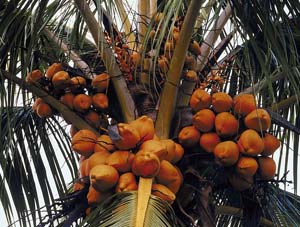The coconut has been popular in lore and on palates for centuries, yet little is known about the history of this palm’s domestication and dispersal around the world.
Now, a WUSTL biologist is embarking on the task of understanding the plant’s history by exploring the genetics of the coconut (Cocos nucifera L.).

Kenneth M. Olsen, Ph.D., assistant professor of biology in Arts & Sciences, has received a $20,000 grant from the National Geographic Society to study the DNA of the plant, which can be used to infer historical relationships among populations. The work will be done in collaboration with Bee Gunn, a research specialist at the Missouri Botanical Garden.
“The coconut played a crucial role in the history of human exploration and dispersal across the tropics, and it continues to play a fundamental role in human societies today,” said Olsen, who is also in the environmental studies program in Arts & Sciences.
“As a portable source of nutrition and water, the coconut was critical for humans to be able to voyage, establish trade routes and colonize lands in the Pacific Rim, coastal India, Africa and South America.
“Our preliminary DNA sequence data show genetic variation within the coconut, and this is key to delineating historical relationships among different populations.
“Fossil data indicate that the coconut underwent an ancient dispersal event that predates human activity. This early dispersal is expected to have created a genetic signature that can be traced by examining the genetic structure of plants sampled across the species range.”
Superimposed on this ancient ‘phylogeographic’ structure is the more recent history of human dispersal, cultivation and domestication, Olsen continued.
“Existing genetic data, while limited, suggest that the most highly domesticated ‘dwarf’ form grown worldwide is most closely related to Pacific populations,” he said.
Both historically and today, the coconut has myriad uses as a source of food, drink and fuel. Every part of the plant is used. Recently, coconut oil has been manufactured into biodiesel fuel in the Pacific, Olsen said.
He added that more than 11 million hectares (one hectare is equal to 2.47 acres) of land are now planted in coconut in 86 tropical countries.
Olsen will study the phylogeography of C. nucifera and its ancient dispersal; the geographical origin(s) of domestication; the impact of human activities in homogenizing population structure across the species range; and the possible geographical location of the undomesticated wild progenitor populations.